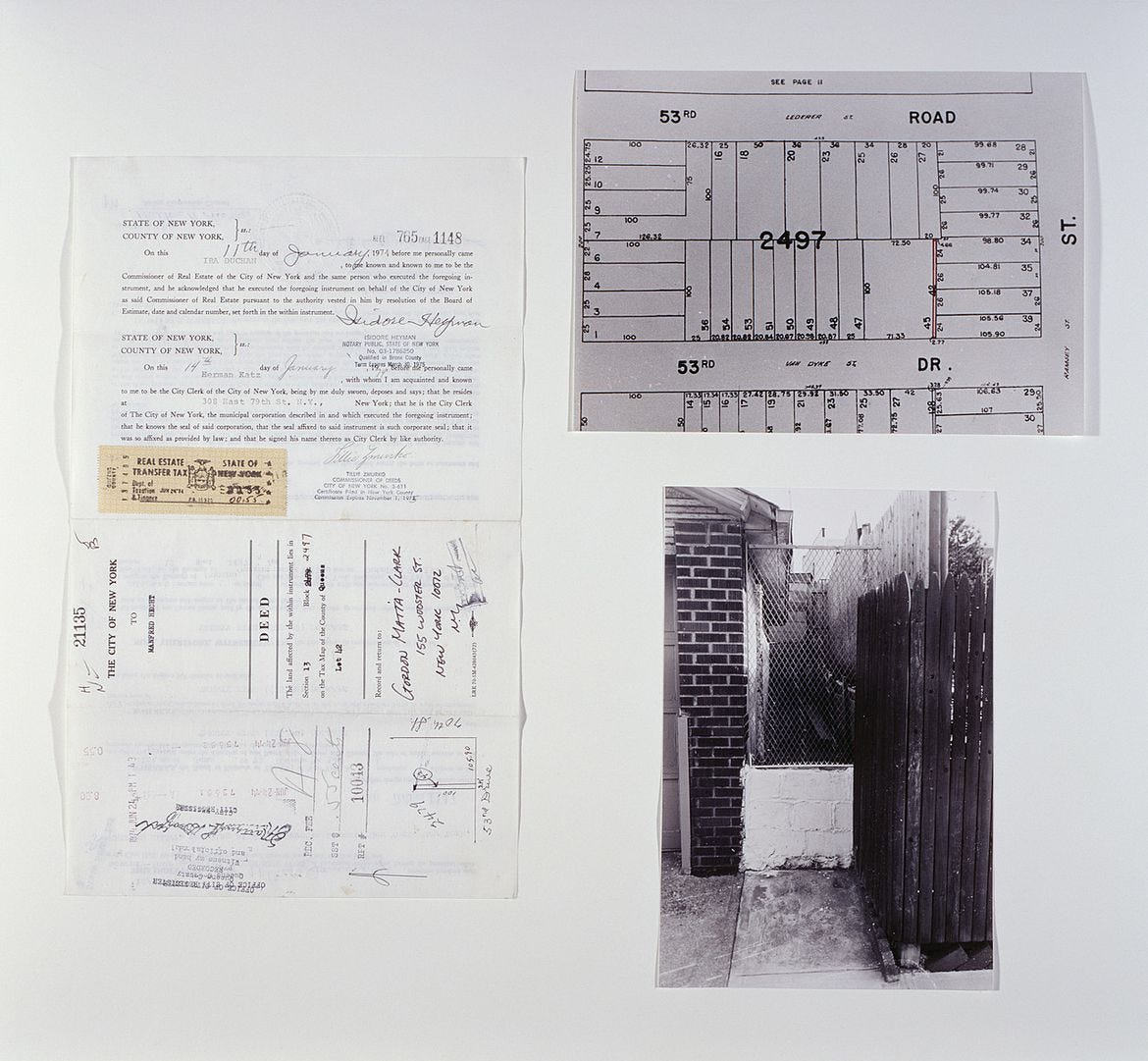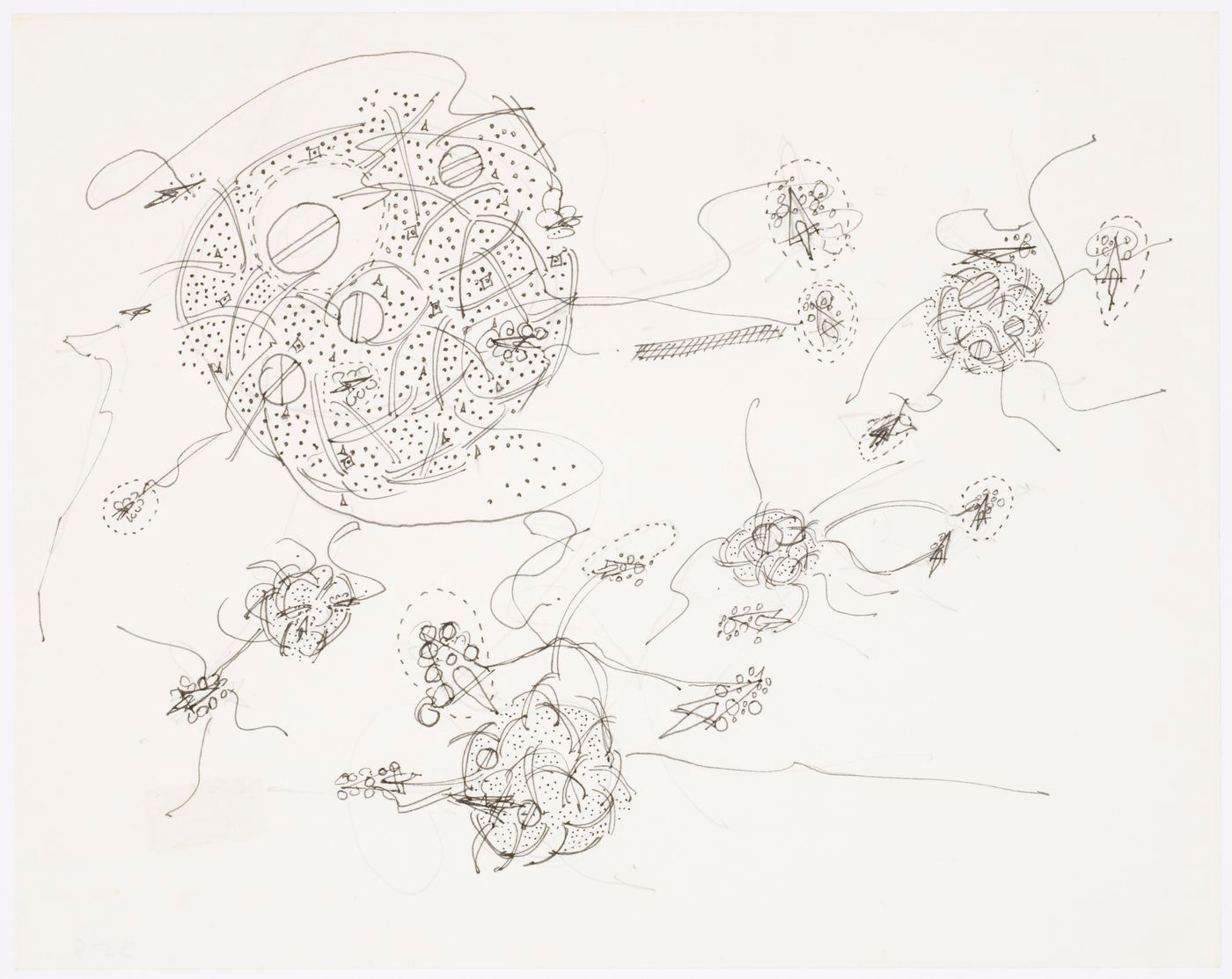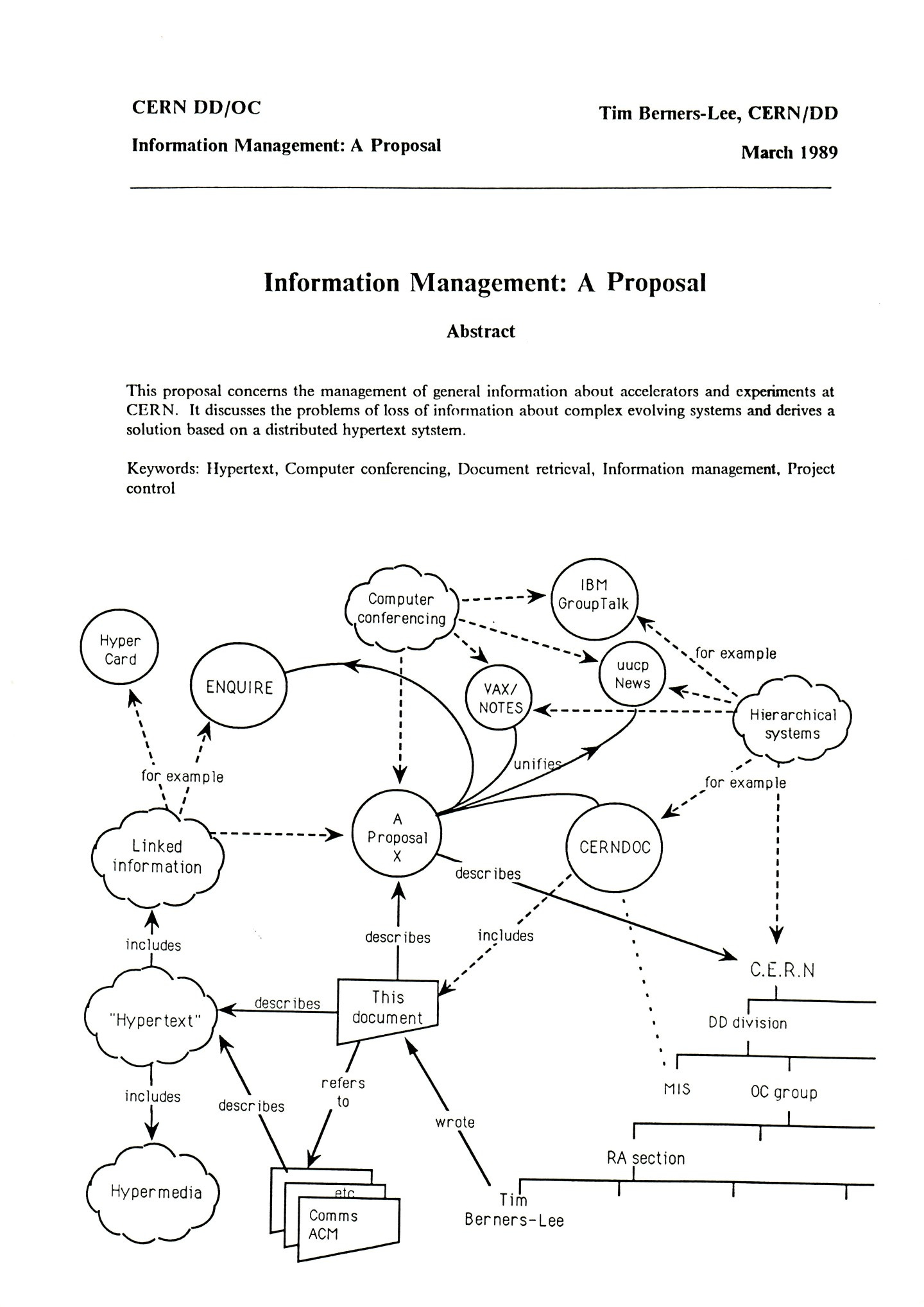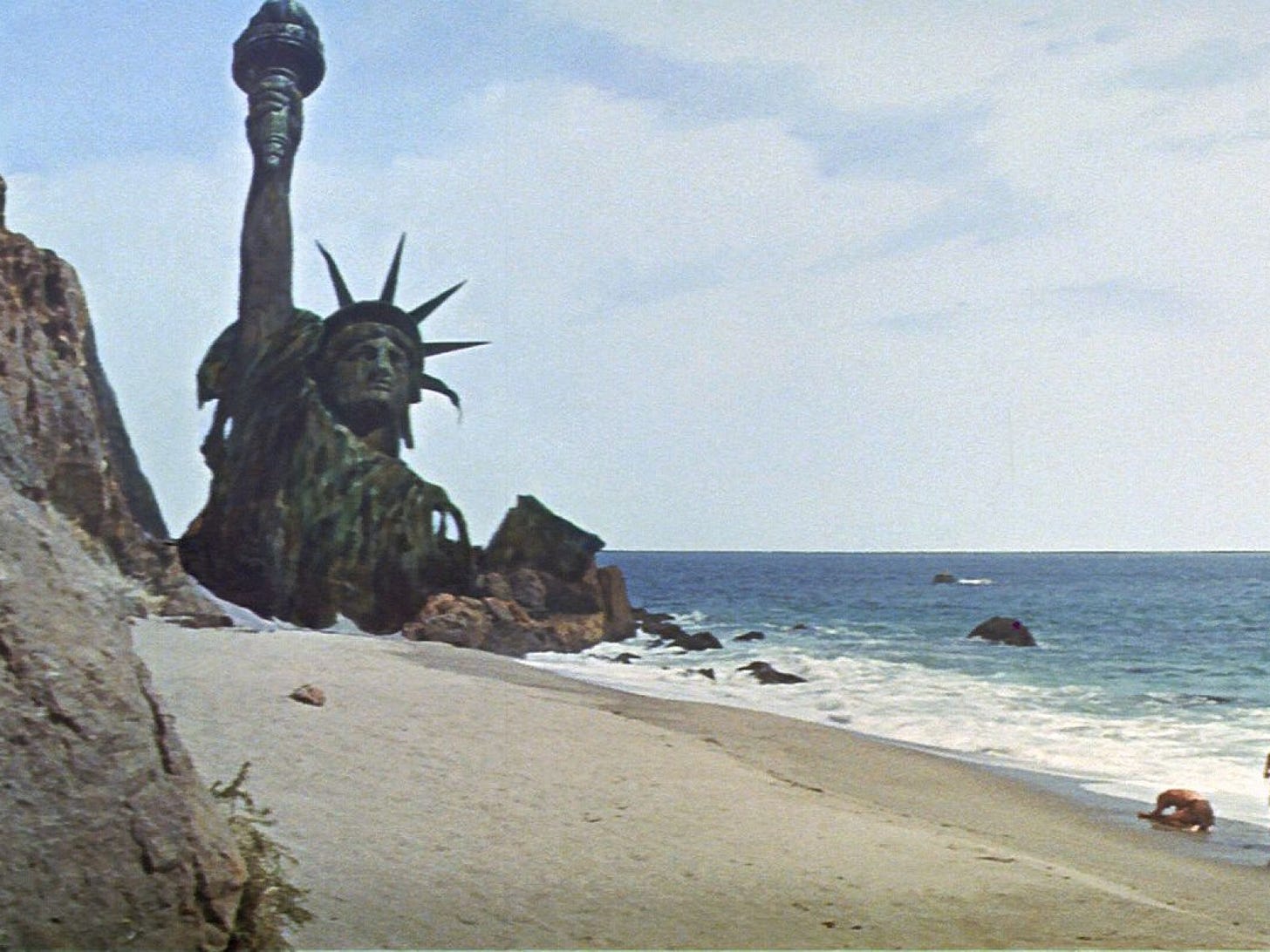You Have Seen The Apes. I Have Seen The Apes. We Have All Seen The Apes. Jimmy Fallon And Paris Hilton Have Apes. Serena Williams Debuted An Ape Last Month. In The Time It Takes To Read This Piece, Several Other Prominent Athletes Or Media Personalities Will Unveil That They, Too, Have Purchased Apes.
What Follows Is A Wandering Essay About Apes, Art, And Ownership. If You Have Committed To Never Reading Another Word About Crypto, NFTs, And Cartoon Profile Pictures, I Understand. If You’re Expecting A Warm Embrace Or A Scathing Takedown Of The Crypto Scene As A Whole, This Will Leave You Unsatisfied. But If You’d Like To Think A Bit About Where We Are, How We Got Here, And Some Places We Could Go, Pull Up A Chair And Stay Awhile.
—Vitruvius Grind

1
In The Early 1970s, The American Artist Gordon Matta-Clark Purchased Several Pieces Of Real Estate In New York City.1 Sources Differ On The Specifics: Was It Fourteen Parcels Or Fifteen? Were They All In Queens, Or Was One On Staten Island? Was $25 The Final Sale Price Of Each Piece, Or Merely The Starting Bid? In Any Case, Matta-Clark Found Himself In Legal Possession Of A Little Under 1/10th Of An Acre, Spread Across Over A Dozen Lots. Nearly All Were Long, Skinny Scraps Leftover From Previous Real Estate Transactions. The Lots Belonged To The City Until They Were Auctioned Off. Then They Belonged To Matta-Clark.
The Artist Died In 1978, At The Age Of 35. Pancreatic Cancer, Notoriously Aggressive. Despite Being Only A Few Feet Wide (Less In Some Cases), The Parcels In Matta-Clark’s Possession Were Still Assessed A Property Tax, Which Went Unpaid After The Artist’s Death. And So Ownership Of The Lots Eventually Returned To The City.
Matta-Clark Had Plans For The Spaces, Plans That Were Never Fully Realized. The New York Times’ Dan Carlinsky Wrote About The City-Run Land Auctions In 1973, Interviewing Matta-Clark And Others About Why They Made Their Real Estate Purchases:
“Mr. Matta-Clark said he intends to use his new properties in works of art he will create during the next several months. The artworks will consist of three parts: a written documentation of the piece of land, including the exact dimensions and location and perhaps a list of weeds growing there; a full-scale photograph of the property, and the property itself. The first two parts will be displayed in a gallery, and buyers of the art will purchase the deed to the land as well.”2
Matta-Clark Never Held A Gallery Show With 1:1 Scale Photographs Of The Parcels. He Did Document Each With A Smaller Photograph, A Map, And The Deed To The Property, Referring To The Overall Collection As Reality Properties: Fake Estates. These Documentation Collages, Physical Assemblies Of Map, Deed, And Photo, Are Now Themselves Owned By Museums And Collectors. These Entities Do Not Own The Land Itself, Just The Reference To Its Prior Owner.
As Matta-Clark’s Title Suggests, The Reality Properties: Fake Estates Are Both Real And Not. The Land Is Tangible, Extant. If You’re Reading This From An Apartment In Brooklyn, You Can Get On A Train And Go To See The Lots Themselves. A 2003 Project Revisiting Matta-Clark’s Work Did Exactly That. The Photograph Below Shows The Same Sliver Of Land Captured In The Collage Above.

And Here, Via Google Street View, Is The Same Site As Captured In November, 2020. In The Roughly Fifty Years Since Matta-Clark’s Purchase, The Trees Have Grown Taller And Fencing Has Been Reworked But The Land Itself—A Rectangle 100’ Long And 32” Wide, Remains.
What Does It Mean To Own A Piece Of Land Narrower Than Your Own Outstretched Arms? What Does It Mean To Collect An Archipelago Of Micro-Sized Lots Across The City?
The Thing About Land Is That It’s Real And Finite. Its Boundaries Are Contested, Measured, And Enforced, Sometimes Violently So. Legal Ownership Of Land Enables A Whole Host Of Actions Off-Limits To Those Just Passing Through. One Can Build, Demolish, Throw Lavish Parties, Erect Tall Fences, Grow Crops And Live Off Of The Harvest.
This Is The Social And Material Context Of Matta-Clark’s Land Purchases. And Yet, His “Estates” Are Clearly Fake. The Largest Of His One-Time Landholdings Could Hold At Most A Lemonade Stand. Many Of The Sites Are Inaccessible, Tucked Between And Behind Other Properties With Other Owners. Nobody Can Meaningfully Exist In These Micro-Spaces, Much Less Make A Life Or A Profit. Their Artistic Value Is Tied Directly To Their Unsuitability As Actual Places. Matta-Clark Understood This. In A 1974 Interview In The Journal Avalanche, He Told Liza Béar:
“What I basically wanted to do was designate spaces that wouldn't be seen and certainly not occupied. Buying them was my own take on the strangeness of existing property demarcation lines. Property is so all pervasive. Everyone's notion of ownership is determined by the use factor.”3
It Feels Inaccurate To Call The Fake Estates Project A Joke, But There Is A Certain Puckish Quality To It: It Shares The Same Ironic Sensibility That Animates Marcel Duchamp’s Readymades, Robert Rauschenberg’s Erased de Kooning Drawing, And Robert Smithson’s “A Tour of the Monuments of Passaic, New Jersey.” Add To The List Yves Klein’s Exhibitions Of Empty Rooms And Robert Barry’s Controlled Releases Of Inert Gases Into The California Atmosphere.
All Of This Work, In Its Own Ways, Points To Conceptual Misalignments In How We Think About Ownership, Creativity, And Place—Fault Lines In Our Understanding Of Where “Regular Stuff” Ends And “Art” Begins.

2
When I See The Endless Parade Of Apes I Feel Nothing Of This Curiosity And Playfulness.
This Isn’t To Say That Novel, Conceptually-Challenging NFT Art Doesn’t Exist. Artists And Designers Like Holly Herndon, David Rudnick, And office ca Are Pushing Their Own Practices In New Directions Via The Blockchain, And A.V. Marraccini’s Writing On NFTs Gives Me Hope That A Vibrant, Burgeoning Community Exists Outside Of The Various Hypebeasts And Ape-Pushers.
But About The Hypebeasts And Ape-Pushers.
The Bored Ape Yacht Club Minted 10,000 Ape NFT Avatars On The Ethereum Blockchain In April Of 2021.
If You Are Unfamiliar With The NFT World, Let Me Quickly Explain What That Means.4
The Bored Ape Yacht Club
A Group Of Programmers Who Started A Company Together
Minted
Used Complex And Very Energy-Intensive Computers To Generate
10,000 Ape NFT
10,000 Unique, Identifiable, And Trackable Bits Of Computer Code (Non-Fungible Tokens), Each Attached To A Cartoon Drawing Of A Primate
Avatars
(For People To Use As Their Profile Picture On Social Media Platforms)
On The Ethereum Blockchain
Using A Cryptocurrency Platform Designed To Process And Record Agreements Between Users.
In April Of 2021
(https://en.wikipedia.org/wiki/Gregorian_calendar)
They Were Neither The First Nor The Last To Release A Set Of Cartoon Avatars In A Limited Edition Drop: CryptoPunks Claims To Be “The Project That Inspired The Modern CryptoArt Movement,” And Users Not Interested In Bored Apes Or CryptoPunks Can Find Mutant Apes, Monster Apes, Meka Apes, Stoned Apes, Doodles, Fishys, Creepz, Hapes, Lazy Lions, Cool Cats, Beeings, Trillionaire Thugs, Alien Frens, CrypToadz, Cool Monkes, PhantaBears, CryptoBatz, CryptoRayRays, Sacred Skulls, FOMO MOFOS, Big Cats, Sappy Seals, Crypto Unicorns, Cryptoskulls, PartyBears, LaserCats, EthernalElves, Pet Hooligans, Gutter Cats, Little Lemon Friends, Free Guys, SupDucks, Robotos, Magic Mushrooms, Egg Heads, And More On The opensea.io NFT Marketplace.
But The Bored Apes Are The Most Successful, In Terms Of Average Resale Price And Celebrity Hype. To Someone Only Marginally Clued-In To The Whole NFT “Thing,” A Square JPEG Of A Scowling Cartoon Ape Selling For Many Thousands Of Dollars Is Probably The First Thing That Comes To Mind.
And So, In The Bored Ape Yacht Club’s Own Words,
“When you buy a Bored Ape, you’re not simply buying an avatar or a provably-rare piece of art. You are gaining membership access to a club whose benefits and offerings will increase over time. Your Bored Ape can serve as your digital identity, and open digital doors for you.
Every Collection Of NFT Avatars Advertises Itself In This Language Of Exclusivity And Future Returns. To Believe The Hype In The NFT Avatar Scene Is To Take The Above As Prophecy: These Cartoon Profile Pictures Are Valuable Pieces Of Art. Before Long, Everyone Who’s Anyone Will Have Them. The More Valuable Your Profile Picture (Or Even Better—Your Collection Of Pictures), The More Privileges You’ll Be Afforded In The Clubs, Private Islands, And Smoky Back Rooms Of Our Digital Future. Best To Secure Your Slice Of Tomorrow By Sending Us Your Money Today.
As Many Other Writers And Tweeters Have Discussed, The Most Exciting Parts Of Our Internet Lives Involve Creating, Copying, Sharing, Connecting. The Rise Of Megaplatforms Like Facebook and Twitter Have Already Homogenized So Much Of Our Online Experience. Everything Arrives Pre-Packaged, Neatly Delivered In Infinite Feeds With Blue-Toned Accents. Will Our Experience Of The Internet And The Perpetually-Promised “Metaverse” Be Any Better As An Endless Series Of Walled Gardens Each Filled With 10,000 Pre-Designed Chattering Apes, United Not By Interest Or Location Or Politics But Merely By Virtue Of All Owning The Same Type Of Picture? Is That A Future We Want?
Of Course, It Can Always Get Dumber.
A Relatively New-Ish NFT Project Called color.museum Promises To Put Color Itself Up For Sale On The Blockchain:
“A Color NFT represents a new category of NFT: a Meta NFT. Essentially, a Meta NFT is usable as a building block to spawn new NFTs, or derivative NFTs—and other products and experiences limited only by the imagination of creators, and in the case of Color NFTs, what they can do with color.”
The Developers Of The Color Museum Intend To Develop A Competitor To The OpenSea NFT Marketplace, Distributing Royalties To The “Owners” Of Each Individual Color Used In Every NFT Avatar Bought And Sold.5
I Remember My Father Teaching Me Some Very Rudimentary HTML In The Late 1990s. I Was So Excited By The Seemingly Infinite Potential, That I Could Pick Any Color Background I Wanted, Make The Text Any Size I Wanted, Insert A Picture Wherever I Wanted, Just As Long As I Could Remember The Correct Lines Of Code. I Felt So Much Potential. Fast Forward To Today And Crypto-Speculators Are Carving Up The Colors Of The Rainbow In Hopes Of A Big Payday, And All I Can Think Is That They’ve Ruined It All.
Interlude I
Also Released In 1968 Was Stanley Kubrick’s Film 2001: A Space Odyssey, Something Of A Collaboration-Adaptation Hybrid With The Science Fiction Author Arthur C. Clarke’s 1968 Novel Of The Same Name.
The First Sixteen-Or-So Minutes Of The Film Are Dedicated To “THE DAWN OF MAN,” A Sequence In Which A Group Of Pre-Homo Sapiens Apes Have A Transformative Experience Somewhere In The Cradle Of Civilization. They Pluck Small Grasses And Shrubs From The Dirt. They Chew Them Idly. They Stare Off Into The Middle Ground. They Grunt At Each Other. They Grunt At A Pack Of Wild Tapirs That Wander Into Their Proximity. A Leopard Springs In From Out Of Frame, Killing One Of The Apes. The Rest Mourn, Then Continue Chewing. Day Turns To Night Turns To Day. Life—And Death—Goes On. The Apes Look, To Be Honest, Bored.
One Morning, A Strange Black Rectangular Monolith Appears In The Watering Hole. It’s About Two Ape-Lengths Tall, Maybe Half-An-Ape Across, And Only A Foot Deep. Black And Smooth. Possibly Reflective? It’s Hard To Tell. The Apes Surround It. Inspect It. Touch It. Run Their Hands Against Its Face. When They Look At The Monolith, Do They See A Black Void Or Do They See Themselves?
After Pondering The Monolith, The Apes Are Changed. They Wield Tools. A Bone Becomes A Club. Wild Tapirs Become Food. Other Apes Become Victims In Skirmishes Over Territory. Competition Reigns.
The Monolith, A Hyperadvanced Technological Entity, Gave The Apes A Technology To Improve Their Lives And Right Away They Set About To Claiming And Killing Everything In Sight.
3
Gordon Matta-Clark’s Best-Known Projects Are More Tangible And Tactile Than The Fake Estates. Pieces Called Splitting, Conical Intersect, And Office Baroque Each Saw Matta-Clark Taking A Saw To Structures In New Jersey, Paris, And Antwerp Respectively. In Each Case Architectures Previously Presumed To Be Whole And Indivisible—Complete Buildings, Even—Are Shown To Be No More Solid Than Scraps Of Paper.



All Three Were Undertaken In Buildings Otherwise Slated For Demolition. When I Look At The Pictures, There’s A Feeling Of The Uncanny. I Know Well How Buildings Are Made, What Materials Lie Within The Walls And Floors Of The Structures Around Us. But To See Them Laid Bare Like This Is Unsettling, Like Bumping Into An Anatomical Teaching Model On The Subway.
The Projects Play Into The Same Provocative Uselessness Of The Fake Estates. Just Like A Piece Of Property Too Narrow To Do Anything With, Who Wants A Building That Can’t Keep Out The Cold And The Rain, With Whole Rooms Blocked Off By Gaps In The Floor?
Interlude II
One Of My Favorite Books As A Child Was Antoine De Saint-Exupéry’s The Little Prince, Published In 1943. The Story, Lavishly Illustrated By The Author, Tells Of A Small, Childlike Prince From A Distant Planet Who Travels The Cosmos And Tries To Make Sense Of What He Encounters.
On One World He Meets A Businessman Eagerly Tallying Up Every Star He Can See. The Little Prince, In His Perpetual Curiosity, Tries To Learn More:
"How is it possible for one to own the stars?"6
"To whom do they belong?" the businessman retorted, peevishly.
"I don't know. To nobody."
"Then they belong to me, because I was the first person to think of it."
"Is that all that is necessary?"
"Certainly. When you find a diamond that belongs to nobody, it is yours. When you discover an island that belongs to nobody, it is yours. When you get an idea before any one else, you take out a patent on it: it is yours. So with me: I own the stars, because nobody else before me ever thought of owning them."
The Little Prince Pushes For More Clarity, For A Better Understanding:
"If I owned a silk scarf," he said, "I could put it around my neck and take it away with me. If I owned a flower, I could pluck that flower and take it away with me. But you cannot pluck the stars from heaven . . ."
"No. But I can put them in the bank."
"Whatever does that mean?"
"That means that I write the number of my stars on a little paper. And then I put this paper in a drawer and lock it with a key."
"And that is all?"
"That is enough," said the businessman.

4
While Collecting Images For This Piece I Came Across A Matta-Clark Project I Hadn’t Seen Before. The Canadian Centre For Architecture, Which Holds Matta-Clark’s Archives, Lists Ten Drawings Grouped Under The Title Immune Vs. Cancer Cells.
The Catalog Entry Reads:
Dates of creation
[1978]
Level of archival description
File 13
Extent and Medium
10 drawings
Scope and Content
File consists of fanciful drawings made in 1978.
File contains drawings.
Reference Number
CP138.S5.D13
All Ten Drawings Are Graphite On Paper, Roughly 8”x11” In Size. Some Have Been Embellished With Black Ink On Top Of The Graphite. They Must Have Been Made In The Last Months Of Matta-Clark’s Life, Between His Cancer Diagnosis And His Passing In August Of 1978. Of The Ten Immune Vs. Cancer Cells Pieces In The CCA Collection, Only One (Above) Has Been Digitized And Made Available For Viewing Online.
I Don’t Know Matta-Clark’s Intentions For These Drawings, Or His Frame Of Mind While Working On Them. Some Of The Lines Look Erratic And Scattered. Some, Like The Careful Dashes Surrounding The Cells, Look To Have Been Drawn More Slowly. It’s Easy To Imagine The Artist As Nervous, Frightened, And Sad In The Last Months Of His Life. I’m Sure I Would Be Were Our Positions Reversed.
But I Also See In The Drawing An Intense Curiosity And Desire To Understand. Perhaps By Sketching The Battles Unfolding Within His Own Cells, Matta-Clark Hoped To Gain A Closer Knowledge Of Them. The Drawings Wouldn’t Perform Medical Miracles Or Open Doors To Some Grand Future, But Just Make The Foreign In The Present A Little More Familiar.

5
In An Odd Historical Coincidence, Gordon Matta-Clark’s Sketch Of Immune Cells Bears A Passing Resemblance To Tim Berners-Lee 1989 Diagram Of What Would Become The World Wide Web. One Is A Deeply Personal Inquiry, The Other A Founding Document Of Modern Life. Tim Berners-Lee Is Of Course Not To Blame For All Of The Wonderful And Horrible Things This System Has Supported In The Past 30 Years. But If One Wanted To Assemble A Fake Estate For The Internet Itself, This Image Might Well Be The Deed.
The Bored Apes And Their Ilk See The Future As Small And Finite: Full Of Things That Can Be Quantified, Owned, And Locked Away, The Riches Shared With The Elite Few Who Buy In Early Enough. Art As Investment Vehicle, Art As Ticket To The Next Big Thing, Art As What Separates The Privileged Few From The Unwashed Masses. There’s A Common Acronym In Crypto Circles, NGMI, Or Not Gonna Make It. It Refers To The Doubters, The Haters, The Skeptics, Those Too Selfish Or Foolish Or Indecisive To Fully Jump On The Bandwagon.
Perhaps I Just Don’t Get It, But If This Is Where We’re Headed, I Don’t Want to Make It. I Think About This Future And My Eyes Close Halfway. My Mouth Closes And The Corners Of My Lips Turn Downward. I Can Feel My Brain Cells Turning Off And Going Home For The Day. If This Is The Future, Then I’m So, So Bored Of It Already.
I’ve Drawn On Several Sources For The Matta-Clark Portions Of This Essay, Including This Piece By Mariabruna Fabrizi, The 2003 “Odd Lots” Project As Documented In Cabinet, And Stephen Walker’s 2009 Book, Gordon Matta-Clark: Art, Architecture and the Attack on Modernism.
“‘Sliver’ Buyers Have A Field Day At City Sales,” October 14, 1973.
I Could Not Track Down A Digital Copy Of This Issue Of Avalanche (December 1974), But Portions Of The Interview Are Quoted In Several Of The Sources Noted Above.
If You Are Extremely Familiar With The NFT World, Please Angrily Tweet At Me (@VitruviusGrind) Regarding Any Misunderstandings Or Oversimplifications.
Incidentally, If This Scheme Works, The Transaction Fees Associated With Each Sale Will Go To The Color Museum Developers And Funders Instead Of The OpenSea Ones, Probably Making A Handful Of People Very Rich. How About That?
Quotes Are Taken From The 1943 English Translation By Katherine Woods.







